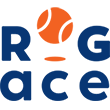When working with young athletes, our primary goal is to foster a love of the sport that we’re already so passionate about. If our athletes don’t enjoy playing tennis, they won’t feel motivated to improve or get a chance to develop a meaningful relationship with this incredible sport. In order to help our athletes grow as players and have fun doing it, we follow a specific, cohesive training methodology inspired by our neighbors across the pond.
The European Approach
ROGace follows the European training methodology, which focuses on helping our athletes develop the skills and confidence necessary at every stage before advancing in their tennis training. Ever notice that the list of tennis greats is dominated by European players? They tend to be better at tennis than Americans because of this approach, which emphasizes mastery over proficiency. It influences every aspect of our program and coaching techniques—even our balls are shipped in from the UK.
In adherence to a more European approach, we keep our athletes on appropriately sized courts with appropriately sized equipment until they are physically and technically ready to advance. We pride ourselves on our emphasis of gameplay-based, individualized assessments, instead of placing players based solely on metrics like age and height. Each player advances through a series of levels on a court that’s best suited to their age, size and ability before they’re able to move to a larger one.
Mastering Every Milestone
In sports like gymnastics or figure skating, athletes are judged based on a strict set of guidelines. It is possible to achieve a perfect score and therefore deliver a “perfect performance.” In tennis on the other hand, prowess is difficult to quantify. One of the best players of all time, Roger Federer, has achieved “only” around 54% of total points won. This means that he has lost around 46% of all tournament points he’s ever played.
This characteristic ambiguity poses a challenge for U12 tennis training. Guidelines for what the youngest players should be working on and what they should be able to achieve are either very vague or totally absent. It’s not clear how to build a strong foundation that will give each player the highest chance of success. This creates an impulse to measure all improvement with court sizes, ball colors and racket sizes. At ROGace, we understand that those metrics are at best severely incomplete and at worse blatantly wrong, so we made it our mission to provide alternative means to gauge progression.
While other training methods emphasize checking boxes to advance quickly through levels, we focus more on gameplay and physical capability. This encourages mastery of every skill in the most manageable environment, so our players are confident that they are totally prepared to advance when the time comes. We don’t want to rush the process—it’s not about moving up quickly, it’s about becoming a great tennis player.
We consider ourselves a high-performance training program for children of all skill levels. This simply means every player in our program receives world-class training that allows them to be the best they can and take their tennis journey as far as they wish. We think this methodology helps young players get a better sense of their aptitude for and interest in a sport that they may not be as familiar with compared to soccer, baseball or hockey. Guidelines are specific and thorough, and players are able to visualize and aspire to measurable goals while tracking their progress. It also makes it easier for parents to follow along, motivate their athletes and help them practice, and communicate with coaches. This approach to training makes it easier for younger or less experienced players to develop smart habits and proper technique from the very beginning.
Benefits for Every Player
There are a lot of benefits to training young athletes this way, whether they’re aspiring pros or not. When players develop a strong grasp on the strokes and strategy from the earliest stages of learning the game, they’re more likely to stick to good habits. As they grow and advance, they’ll continue to build on a solid foundation of knowledge and skills necessary to becoming competitive players. It also makes them less injury prone and means they’re less likely to get frustrated or burn out. We aim to foster confidence at every level and design our training to be fun and engaging, with games and skills sessions that make kids excited for every practice.
If you’re interested in learning more about our training methodology or what sets us apart, please don’t hesitate to contact us. We regularly enroll new players and will work with you to ensure your athlete gets started on the right foot, at the right level to set them up for long-term success and meaningful improvement.

